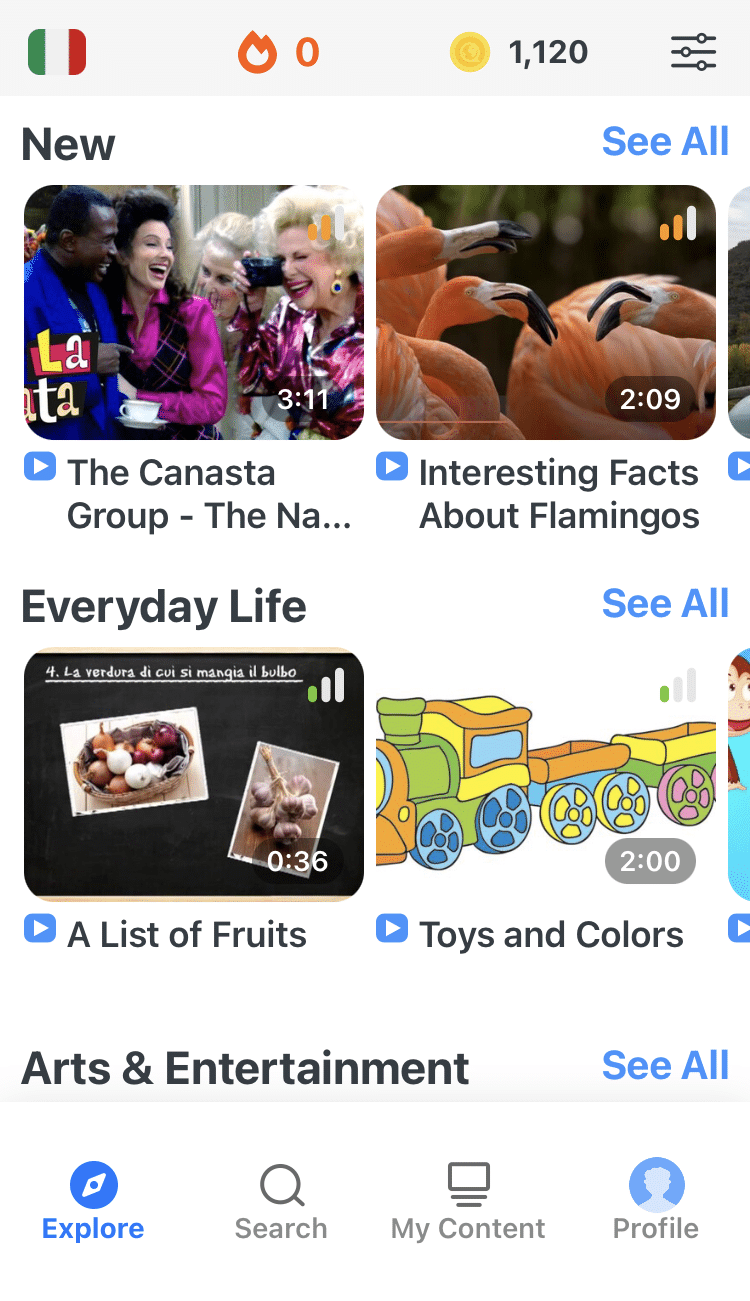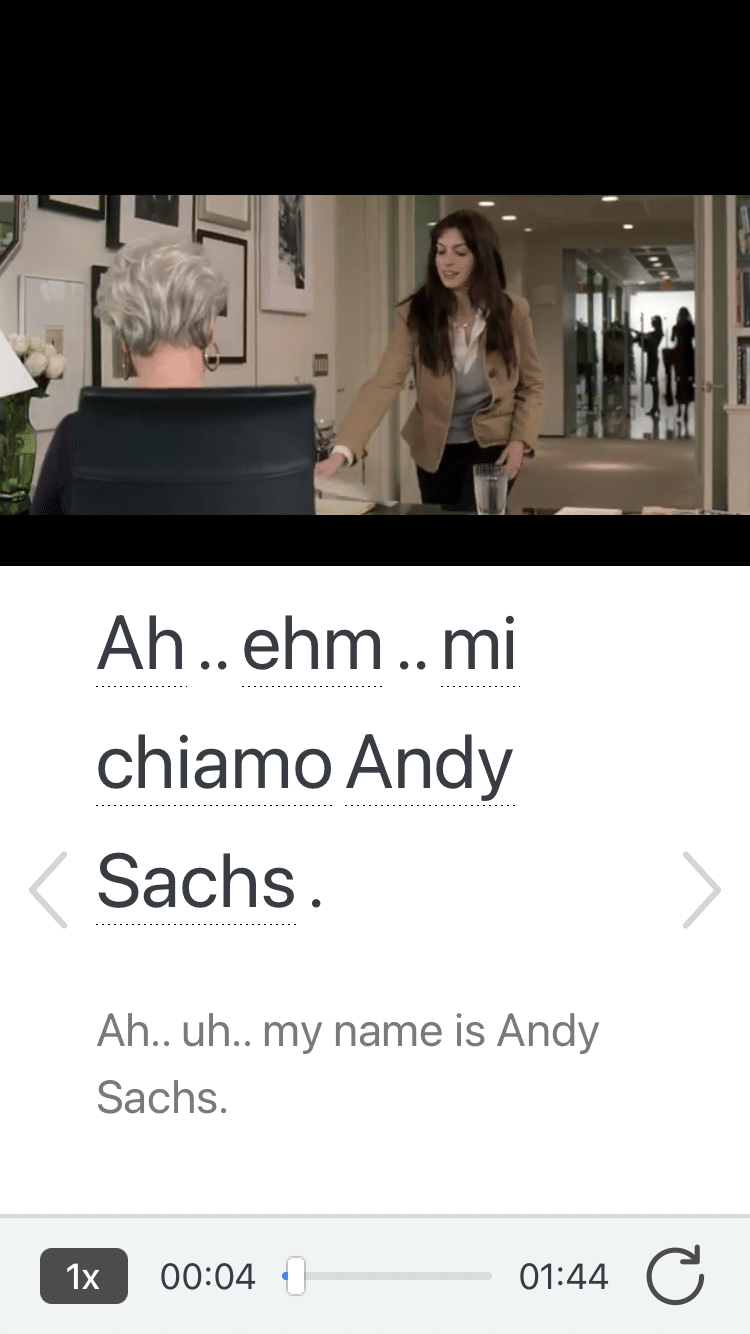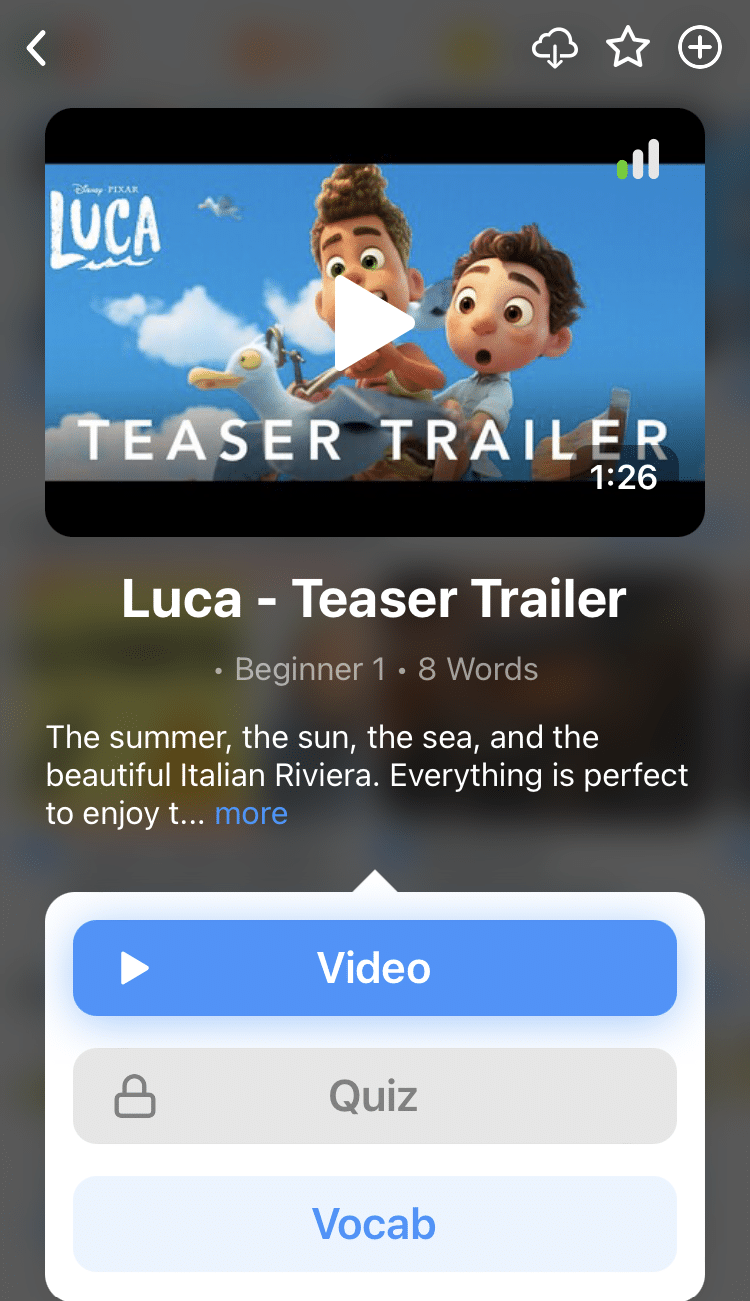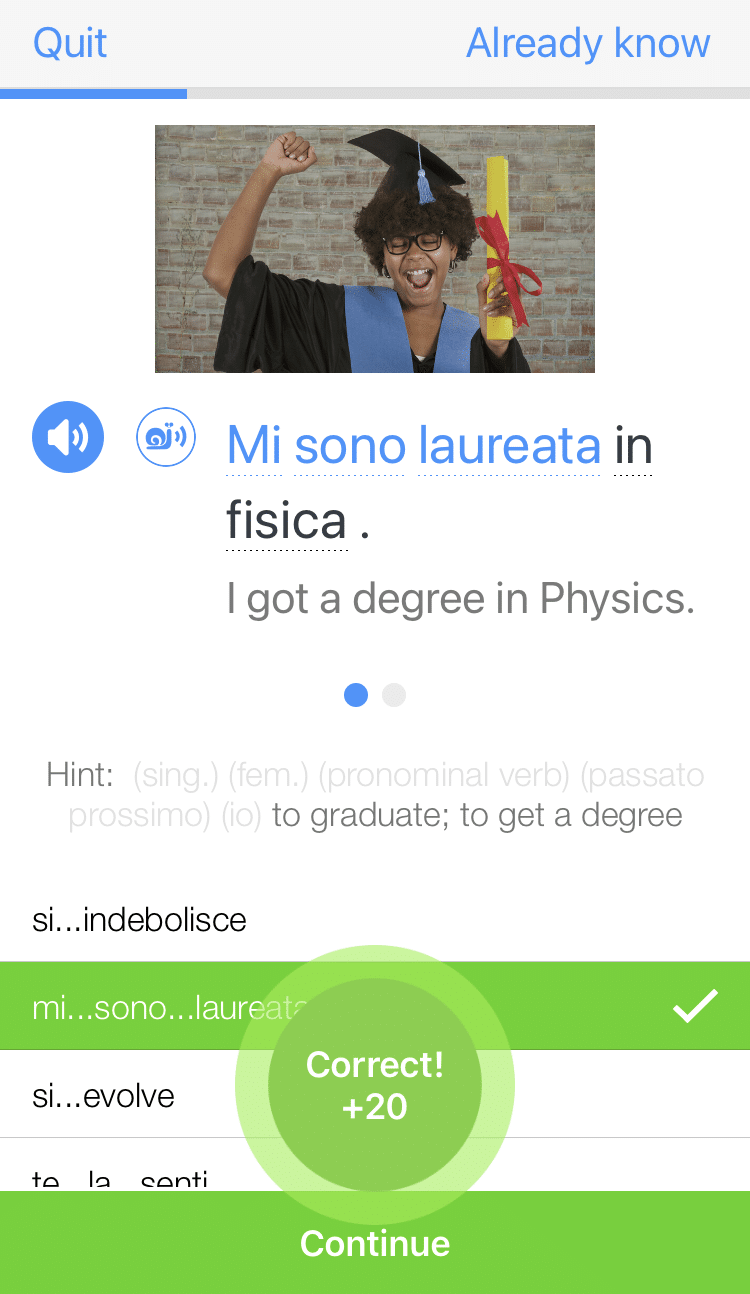
32 Italian Textbooks for Streamlining Your Italian Learning Experience
Italian language textbooks can serve as the backbone to successfully learning Italian.
They offer a systematic look at the language and often compile grammar with vocabulary as well as cultural tips to streamline your language learning experience.
Here are 32 Italian textbooks that offer all that and more—from beginners to advanced learners. At the end, we’ll also provide tips on how to get the most out of your Italian textbooks.
So, let’s dive in!
Contents
- 1. “Italian Made Simple”
- 2. “Living Language Italian”
- 3. “Italian: The Ultimate Guide for Beginners”
- 4. “Talk Italian Box Set”
- 5. “Learn Italian for Beginners”
- 6. “Learn Italian: Italian Short Stories”
- 7. “The Complete Idiot’s Guide to Learning Italian”
- 8. “Italian Language and Culture: Beginner”
- 9. “Easy Italian Reader”
- 10. “Short Stories in Italian for Beginners”
- 11. “Italian Short Stories for Intermediate Learners”
- 12. “Complete Italian Beginner to Intermediate Course”
- 13. “Better Reading Italian”
- 14. “Practice Makes Perfect Italian Vocabulary”
- 15. “Enjoy Intermediate Italian”
- 16. “Facile facile” (Easy Come Easy Go)
- 17. “Italian Verb Tenses”
- 18. “Dirty Italian”
- 19. “Short Stories in Italian”
- 20. “Ecco!: An Introduction to Advanced Italian”
- 21. “Nuovo Magari C1/C2” (New Maybe)
- 22. “Ultimate Italian Advanced”
- 23. “Italian Grammar (Barron’s Grammar Series)”
- 24. “Soluzioni: A Practical Grammar of Contemporary Italian”
- 25. “A Reference Grammar of Modern Italian”
- 26. “English Grammar for Students of Italian”
- 27. “Practice Makes Perfect: Advanced Italian Grammar”
- 28. “Esercizi di grammatica italiana per stranieri” (Italian Grammar Exercises for Foreigners)
- 29. “Rick Steves’ Italian Phrase Book & Dictionary”
- 30. “Streetwise Italian Dictionary/Thesaurus”
- 31. “Damnatio Memoriae”
- 32. “Contemporary Italian Women Poets”
- How to Get the Most Out of Your Italian Textbooks
- And One More Thing...
Download: This blog post is available as a convenient and portable PDF that you can take anywhere. Click here to get a copy. (Download)
1. “Italian Made Simple”
Level: Beginner
This textbook offers a beginner’s look at grammar and vocabulary. Learn Italian with common expressions and a selection of contemporary Italian readings on culture and history.
All the grammar and vocabulary acquired in this textbook is reinforced with exercises, language games and puzzles.
Best of all, this textbook offers a pronunciation guide, an Italian-English dictionary and answer keys to exercises and test questions. It’s a great beginner-Italian package for starting your language learning experience.
2. “Living Language Italian”
Level: Beginner to advanced
Boasting a method that’s backed by linguistic science, this textbook really is the complete course for your Italian self-study needs.
Besides the 46 comprehensive lessons, exercises, cultural notes and grammar summary guide, this textbook is more than a textbook—it’s a course!
In addition to the three books, “Living Language Italian” comes with nine audio CDs complete with vocabulary drills, dialogues and audio exercises to help you speak Italian like a native.
3. “Italian: The Ultimate Guide for Beginners”
Level: Beginner
This is actually three manuscripts in one book and offers one of the most comprehensive Italian learning programs for those who have little to no knowledge of the language.
The first book contains 10 chapters and is a traditional textbook with grammar explanations, pronunciation rules and tips for learning Italian.
The second book is a collection of short stories that use the vocabulary and grammar from the first book in natural settings and situations. The third is a phrasebook containing over 1,000 useful terms, including plurals, time, how to order food and more.
4. “Talk Italian Box Set”
Level: Beginner to lower-intermediate
This is the perfect combination for learners who want to bridge multiple stages of the Italian language learning journey.
The first textbook is for absolute beginners; the second is for upper-beginner and lower-intermediate learners. Each contains 10 chapters on topics such as travel, ordering food and asking for directions.
Textbook chapters include readings, grammatical and vocabulary explanations and opportunities to practice with exercises. There are also four audio CDs in clear, native Italian speech, plus additional listening exercises.
5. “Learn Italian for Beginners”
Level: Beginner
This textbook uses conversations between Italian speakers to teach the language. The content helps prepare learners for real interactions while breaking down the language in a practical and applicable way.
Each dialogue and situation is given in native Italian with an English translation, as well as explanations of the Italian vocabulary and grammar constructions.
Topics include the basics, such as greetings and small talk, as well as numbers, time and parts of the body. This book covers most common conversation topics that one can expect to have in Italian.
6. “Learn Italian: Italian Short Stories”
Level: Beginner
Following the book listed above, the author, Paul Riva, has also written this companion textbook containing 18 short stories for learning Italian.
Based on topics presented in the textbook, each short story is broken into paragraphs alternating between Italian and English translations.
This is a great complement to the authentic Italian dialogues of the original textbook.
7. “The Complete Idiot’s Guide to Learning Italian”
Level: Beginner
This book is particularly helpful for Italian verb conjugations, grammar and vocabulary. Don’t let the title throw you off!
The style is conversational nearly to the point of being long-winded, but that’s likely preferable to being left hanging on a tricky Italian grammar point.
This edition includes a one-hour-long audio lesson of the author and a native Italian speaker explaining practice sessions throughout the book. And with language puzzles and conversational practice sessions, this is a great option for beginner learners.
8. “Italian Language and Culture: Beginner”
Level: Beginner
This book is designed to work in tandem with the “Italian Language and Culture: Beginner (2023-2024)” course available on edX, though there’s valuable information for others, too.
The units are incredibly detailed. Each includes grammar explanations, video transcriptions of the course material, readings and interviews with native speakers.
There are also loads of exercises for you to practice your Italian language skills, as well as helpful reference charts for vocabulary and grammar.
9. “Easy Italian Reader”
Level: Beginner
This book offers super-easy stories accompanied by flashcards, audio recordings, glossaries and exercises to help you practice the words that you learn.
The first part tells the story of Christine, an American in Italy. It prepares learners for the vocabulary and cultural experiences they would encounter on a similar trip.
The second part is just a bit more advanced, explaining various episodes in Italian history. Part three offers some authentic contemporary literature selections.
10. “Short Stories in Italian for Beginners”
Level: Beginner
While it doesn’t include complete grammatical explanations or a thorough breakdown of the language, this book is invaluable for beginner learners.
It’s perfect for exposure to actual Italian readings without being overwhelming. It consists of eight “unconventional” short stories for Italian learners.
The stories focus on common vocabulary relevant to the beginner learner, but the situations are humorous and/or interesting enough to be entertaining. Each story also includes a short summary, a glossary and comprehension questions.
11. “Italian Short Stories for Intermediate Learners”
Level: Intermediate
This book, by polyglot Olly Richards, follows the previous one and builds on its reading and comprehension skills. It helps the learner develop in the direction of reading native Italian content.
It’s perfect for intermediate learners looking to improve their reading and enrich their vocabulary. Each of the eight specially written short stories includes a summary, glossary and comprehension questions.
The stories move away from beginner subjects and cover more topics pertinent to deeper conversations with native speakers.
12. “Complete Italian Beginner to Intermediate Course”
Level: Beginner to intermediate
One unique feature of this textbook is that it uses a “discovery” method of teaching, which aims to help you better internalize Italian language rules and patterns.
Sample dialogues are presented in text and audio, while basic grammar and vocabulary are broken down in easy to understand ways, with exercises for practice.
The book also offers cultural notes for some context on how the language is actually employed. These help you understand what you should say to fit into the culture, and not just how to say it.
13. “Better Reading Italian”
Level: Upper-beginner to intermediate
This book provides short texts for Italian learners on a variety of subjects that are of interest to students: slow food, the Italian countryside, fashion, design, Italians’ opinions of American culture and more.
Offering “real-world” texts, Italian vocabulary and phrases, this book is great for advancing your Italian language skills.
Following each piece written in Italian you’ll find comprehension questions and exercises to help you get the most of the vocabulary and structures you’ve learned.
14. “Practice Makes Perfect Italian Vocabulary”
Level: Upper-beginner to intermediate
This textbook is organized by themes and focuses exclusively on building vocabulary so learners can populate grammatically-correct sentences with useful, topical words.
In particular, it encourages vocabulary acquisition by analyzing new words based on context and word-building (the process where prefixes, suffixes and even other words are added to a word to give it a new meaning).
There are over 250 exercises and an answer key that allows learners to practice new vocabulary, as well as grammar explanations to assist learners with using their new words properly.
15. “Enjoy Intermediate Italian”
Level: Intermediate
Written by the company Teach Yourself, this textbook teaches intermediate Italian through authentic texts such as poems, songs and conversations between native speakers.
Since the readings focus on native Italian content (rather than content tailored to Italian learners), this textbook helps students comprehend advanced grammar topics, colloquial language and complex vocabulary.
In addition to the almost 300 pages of Italian learning, it also includes two hours of audio for listening comprehension and fine-tuning Italian pronunciation.
16. “Facile facile” (Easy Come Easy Go)
Level: Intermediate
While this textbook is completely in Italian, it still lives up to its name! Most useful for learners firmly at the B1 (intermediate) level, it focuses on specific grammar and vocabulary situations to boost language skills.
This is useful for learners who know what their weaknesses are, or for those who are ready to dive into conversations with native speakers.
Lessons are centered around situations like in the home, the office or on the street, and then the situation is broken down for new grammar and vocabulary.
17. “Italian Verb Tenses”
Level: Upper-beginner to intermediate
In this Italian textbook, each chapter focuses on a different verb tense or mood, so it’s not just a book with tables on each individual verb—it’s so much more.
This guide allows you to learn and perfect the complex rules of Italian verb conjugation, and it features in-depth analyses of every verb tense imaginable.
Topic reviews, grammar tips, crossword puzzles and exercises let you practice, while fun spoken dialogues allow you to hear verbs in their natural usages.
18. “Dirty Italian”
Level: Upper-beginner to advanced
This textbook is a little risqué, but it offers you a chance to acquire phrases and words that you wouldn’t learn in a classroom or a traditional Italian textbook.
It covers Italian insults and modern slang for situations including food, fashion and fun. Vocabulary is sorted into themed chapters ranging from “Howdy Italian” to the more bold “Horny Italian.”
If you’re interested in losing rigid textbook formality and would rather opt for a more relaxed lingo lesson, then “Dirty Italian” is the book for you.
19. “Short Stories in Italian”
Level: Intermediate to advanced
If you want to dive into modern Italian literature but you’re not sure where to start, this might be the place.
Nine short stories from late-20th-century Italian writers are presented here with Italian on one side of the page and English on the other. It’s a great bilingual language lesson book.
There’s a brief English introduction to provide insight about the writers whose works you’ll read, and there are useful notes at the end about Italian language information that you can take away from the stories.
20. “Ecco!: An Introduction to Advanced Italian”
Level: Advanced
The emphasis of “Ecco!” (“Here It Is!”) is growing a more robust vocabulary for advanced learners. There are over 6,000 Italian words and more than 1,000 Italian idioms.
Best of all, both the words and idioms are grouped thematically so you can learn them and look them up in a logical sequence. Explanations of grammar are also given where applicable.
Further, many of the terms have example sentences so that learners can differentiate where certain words fit naturally and when they sound a bit out of place.
21. “Nuovo Magari C1/C2” (New Maybe)
Level: Advanced
This textbook is completely in Italian. It’s specifically aimed at advanced learners who want to fill in the final gaps in their language knowledge.
Excerpts of Italian literature are used as the basis for many of the 12 themed chapters. Chapters include readings, grammar explanations of advanced language usage and exercises for practice.
Additionally, each chapter has a video component by native speakers. The book also includes audio for listening exercises focusing on topics such as geography, society, art, history and Italian culture.
22. “Ultimate Italian Advanced”
Level: Advanced
Created by the Living Language company, this textbook contains 480 pages of advanced Italian content plus audio examples and activities.
Each chapter starts with a dialogue of authentic Italian and focuses on an advanced topic, like business Italian or government and politics. There’s also an in-depth look at the grammar, vocabulary and practice exercises.
In fact, the focus of this textbook is business and employment in Italian, so this is a great choice for any learner who wants to work in Italy or travel there on business.
23. “Italian Grammar (Barron’s Grammar Series)”
Level: Beginner to advanced
This textbook is ideal for learners looking to hone their grammar skills and get a systemic look at all of Italian’s intricacies.
Stylized as a “fast-reference” book, it covers parts of speech, sentence structure, punctuation, verbs tenses and moods. It’s also loaded with exercises as well as useful day-to-day vocabulary that beginner textbooks may omit.
With information on punctuation, idioms and pronunciation included in this textbook, it’s a well-rounded language learning resource.
24. “Soluzioni: A Practical Grammar of Contemporary Italian”
Level: Beginner to advanced
This is a fabulous book for beginner, intermediate and advanced learners. It’s structured by parts of speech, moving from nouns to articles to Italian tenses and so on.
Using material from Italian media and literature, the textbook offers vocabulary notes and exercises, helping you to see authentic usage of sentence structures.
With 650 graded practice exercises and an answer key for self-assessment, you’ll be able to track how well you’re doing with your study practice lessons.
25. “A Reference Grammar of Modern Italian”
Level: Beginner to advanced
This book, written in English, mainly focuses on Italian reference grammar. It also covers the spelling and pronunciation of Italian words.
Whether you’re a beginner or an advanced learner, you’ll find that this book provides clear and detailed explanations and that you can easily find the information you need.
It truly is a comprehensive guide to Italian reference grammar that will provide the foundation you need for solid language learning.
26. “English Grammar for Students of Italian”
Level: Upper-beginner to advanced
This textbook covers grammar, nouns, verbs, pronouns, grammatical terms and much more. The goal is to help you understand concepts in English that you can apply to your Italian studies.
Each chapter is divided into two sections: review and answer key. There are also diagrams and charts to summarize various points in the book.
The information within the textbook is simple and clear, allowing beginner learners a better understanding of each lesson provided.
27. “Practice Makes Perfect: Advanced Italian Grammar”
Level: Advanced
This book makes it a point to tackle items that are typically challenging to language students, like object and relative pronouns.
Complex topics are explained clearly through parallels to the English language, which makes potentially daunting concepts much easier to understand. It’s especially useful for anyone who finds themselves getting stuck on specific aspects of grammar and offers a great opportunity to finally master the exceptions and trouble spots for students of the language.
This is a practice guide, so it offers lots of opportunities to actually use the material being covered.
28. “Esercizi di grammatica italiana per stranieri” (Italian Grammar Exercises for Foreigners)
Level: Intermediate to advanced
Since this book is completely in Italian, it’s ideal for learners of least a B1 (intermediate) level or above. It offers Italian grammar from beginner topics to advanced, with a focus on higher-level grammar.
Each section focuses on a specific topic such as sentence structure or verb conjugation. There are also in-depth explanations of the topics and the chance to practice with multiple exercises.
Further, there is a glossary with answers in the back of the book to ensure that you’re using each grammar topic, its rules and its exceptions correctly.
29. “Rick Steves’ Italian Phrase Book & Dictionary”
Level: Beginner
The book is small enough to fit into a coat pocket or purse and is great for beginners traveling to Italy who need a phrasebook relevant to the type of experiences they will have there.
Providing phrases for everyday use—such as ordering a meal or asking where the train station is—this little book is packed with informative and practical information for travelers of all learning levels.
It also offers phonetic spelling and a handy English-Italian and Italian-English dictionary in its pint-size binding. If you’re traveling to Italy, this is the perfect go-to book to carry with you.
30. “Streetwise Italian Dictionary/Thesaurus”
Level: Beginner to intermediate
This book bills itself “The User-Friendly Guide to Italian Slang and Idioms.” Learning a new language comes with learning how to speak like a native, and this book can help you do just that.
With over 2,500 Italian slang and idioms arranged in alphabetical topic order, this is a great book for learners traveling to Italy and those who want to learn common, idiomatic expressions in Italian.
There are also example sentences with English translations, which helps with quickly cross-referencing anything you don’t understand.
31. “Damnatio Memoriae”
Level: Intermediate
This bilingual book provides insight into what it means to be a citizen of Rome, or of anywhere.
It’s a story for pretenders to the Roman throne—and of competing theater troops clashing over the right to stage history. It was written by an Italian-American literary couple, and as it’s a play, the Italian is conversational and the level is quite approachable for the intermediate learner.
The first half of the book is the text of the play in English, and the second is the same text in Italian.
32. “Contemporary Italian Women Poets”
Level: Intermediate to advanced
This booklet contains the works of 25 female Italian authors, all published since World War II.
For each author, there’s a selection of poems in Italian with an English translation on the facing page. The poems are short, so they’re easy pieces to dive into when you only have a few minutes to study.
As authentic Italian literature, the poems in this book also make brilliant conversation pieces for an Italian-English language exchange.
How to Get the Most Out of Your Italian Textbooks
Step 1: Make a word list
The first step to acquiring any language is to learn the words in said language. So naturally, the first step to getting the most out of your Italian textbook is to start a word list.
Every word you come across that you don’t know should be put in a word list. Organize your words by theme or chapter (i.e. house words, days of the week, etc.) as you come across them.
Take the words from a given themed list and create sample sentences to help you remember them. (Write them and say them aloud.)
Step 2: Do the exercises
The majority of Italian textbooks come with exercises, so do them! Exercises reinforce crucial grammar concepts and even vocabulary (see step one). Do each exercise given in the textbook so you can reiterate what it is that you’re learning.
Best of all, most textbooks also have answer keys. Use these to make sure your answers are correct, and figure out why your answers are incorrect when yours don’t match the key.
Step 3: Make notes on grammar
Writing out grammar rules in your own words will help them stick and make sense.
Every time you come across a new grammar point, make sure to write your own notes on it. Keep those grammar notes beside you when doing exercises, especially during activities where your grammar will really be put to the test.
Make sure to review your grammar often. By the time you reach the end of your textbook, you’ll be as much a grammar expert as the book is!
Step 4: Read out loud
Speaking Italian is crucial to pronouncing words correctly and developing your accent, confidence and competence in the language—no matter what learning level you’re at.
If your textbook comes with an audio CD or online audio resource, great. Listen to the recordings and repeat them after the speaker.
No audio? Not a problem. Read everything in Italian out loud—the readings, dialogues and exercises. This is a helpful and necessary practice to have you speaking like a pro in no time.
Step 5: Quiz yourself
Quizzes and tests are different from exercises because you’re not allowed to view your notes or other learning materials while taking them. This is a great opportunity to test your mastery of the language and see where you need improvement.
If your textbook has regular tests for grammar, once again, do them. Like the exercises, these tests will help you improve as well as gauge where you may need more practice.
If your textbook does not offer tests or you want more practice exams, you can check out One World Italiano for online tests of Italian grammar and vocabulary, and Online Italian Club for tests of all learning levels.
So whether you’re a beginner looking for a well-rounded textbook, an intermediate learner wanting to sound like a native speaker, or an advanced learner looking to enhance your grammar and conversational skills, there’s an Italian textbook for everyone on this list!
It can also be helpful to use native media alongside your textbooks so you can see more examples of Italian grammar and vocabulary in context. For example, you could read Italian books, or you could also try watching bite-sized Italian clips with language learning support on FluentU.
FluentU takes authentic videos—like music videos, movie trailers, news and inspiring talks—and turns them into personalized language learning lessons.
You can try FluentU for free for 2 weeks. Check out the website or download the iOS app or Android app.
P.S. Click here to take advantage of our current sale! (Expires at the end of this month.)
Happy learning!
Download: This blog post is available as a convenient and portable PDF that you can take anywhere. Click here to get a copy. (Download)
And One More Thing...
If you're as busy as most of us, you don't always have time for lengthy language lessons. The solution? FluentU!
Learn Italian with funny commericals, documentary excerpts and web series, as you can see here:

FluentU helps you get comfortable with everyday Italian by combining all the benefits of complete immersion and native-level conversations with interactive subtitles. Tap on any word to instantly see an image, in-context definition, example sentences and other videos in which the word is used.

Access a complete interactive transcript of every video under the Dialogue tab, and review words and phrases with convenient audio clips under Vocab.

Once you've watched a video, you can use FluentU's quizzes to actively practice all the vocabulary in that video. Swipe left or right to see more examples of the word you’re on.

FluentU will even keep track of all the Italian words you’re learning, and give you extra practice with difficult words. Plus, it'll tell you exactly when it's time for review. Now that's a 100% personalized experience!
The best part? You can try FluentU for free with a trial.
Start using the FluentU website on your computer or tablet or, better yet, download the FluentU app from the iTunes or Google Play store. Click here to take advantage of our current sale! (Expires at the end of this month.)
































